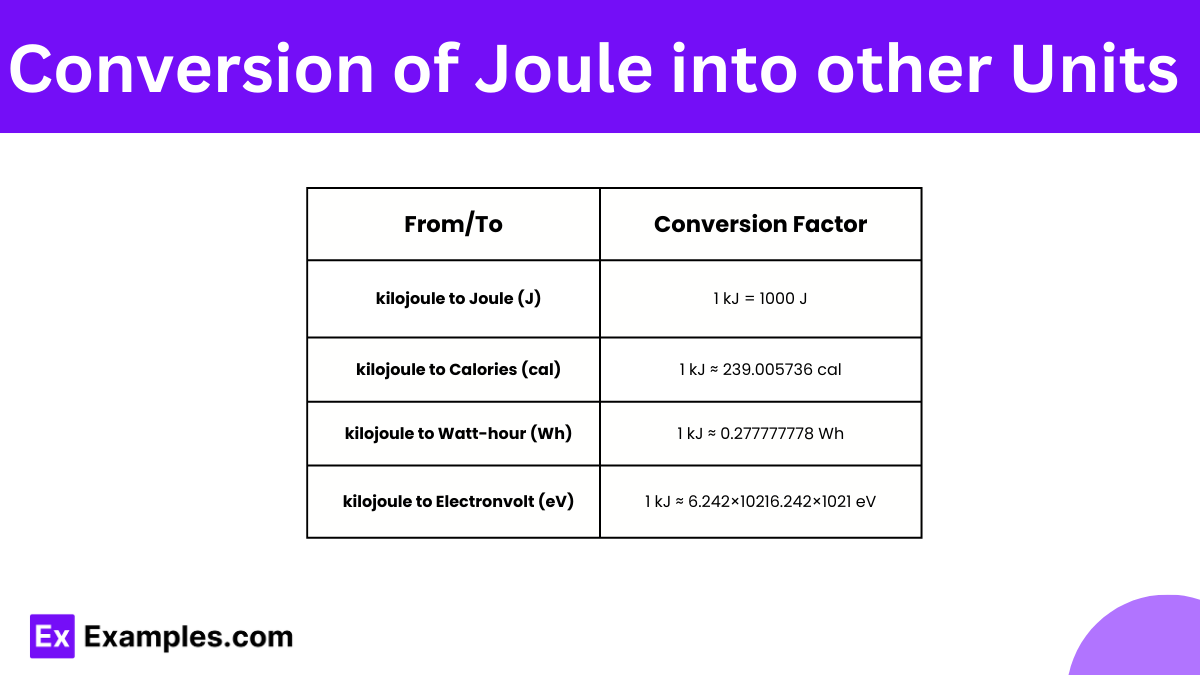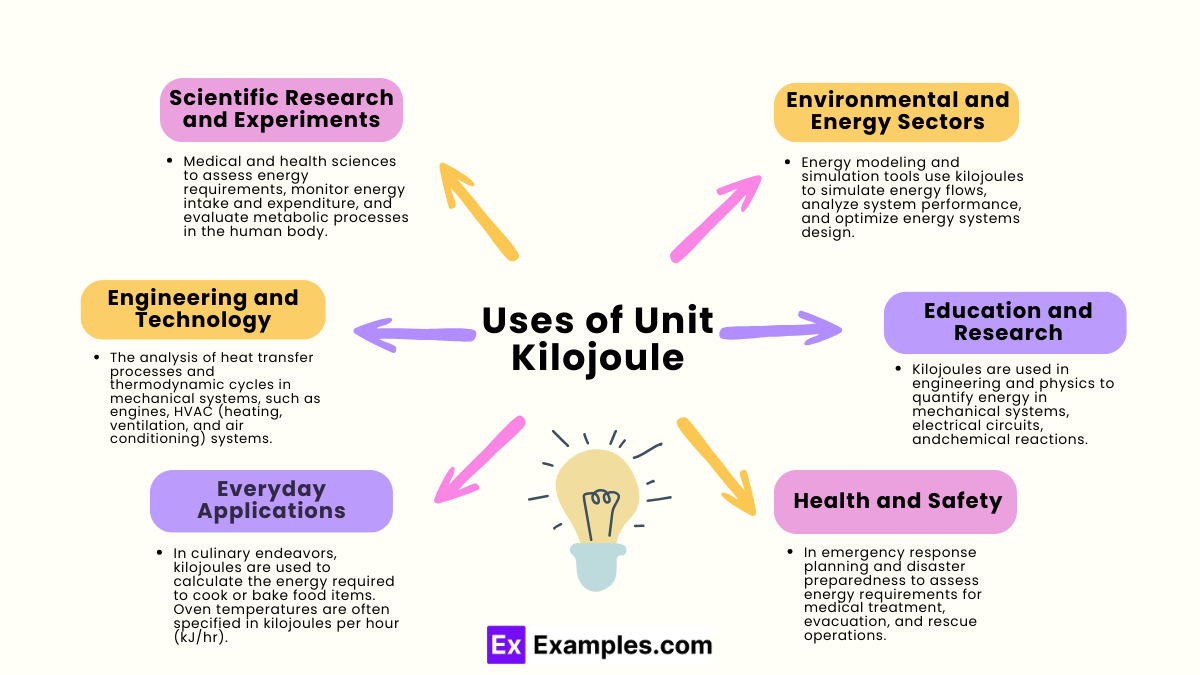What is the symbol for a kilojoule?
kJ
kW
kN
kC

kJ=1000×Joules
| kJ | Kilojoules (unit of energy) |
| J | Joules (unit of energy) |
The fundamental formula to calculate work or energy in Kilojoules is given by:
2. Potential Energy: The energy stored in an object due to its position or configuration is called potential energy, often calculated for objects raised against gravity: P = m×g×h=1kgWhere:
3. The energy used by electrical appliances can be calculated using: E=P×t Where:
| Prefix | Symbol | Value | Equivalent in Joules (J) |
|---|---|---|---|
| Kilojoule | kJ | 103 | 1000 joules (J) |
| Megajoule | MJ | 106 | 1,000,000 joules (J) |
| Gigajoule | GJ | 109 | 1,000,000,000 joules (J) |
| Terajoule | TJ | 1012 | 1,000,000,000,000 joules (J) |

| From/To | Conversion Factor | Example Conversion |
|---|---|---|
| kilojoule to Joule (J) | 1 kJ = 1000 J | 5 kJ = 5000 J |
| kilojoule to Calories (cal) | 1 kJ ≈ 239.005736 cal | 2 kJ ≈ 478.011472 cal |
| kilojoule to Watt-hour (Wh) | 1 kJ ≈ 0.277777778 Wh | 3 kJ ≈ 0.833333334 Wh |
| kilojoule to Electronvolt (eV) | 1 kJ ≈ 6.242×10216.242×1021 eV | 4 kJ ≈ 2.4968×10222.4968×1022 eV |
You’re planning a hiking trip and need to estimate the amount of energy your body will expend during the journey. Using a fitness tracker or online calculator, you determine that your average energy expenditure while hiking is approximately 8 kilojoules (8 kJ) per minute. You plan to hike for 2 hours, so you calculate your total energy expenditure as follows:
Total Energy Expenditure = Energy Expenditure per Minute × Duration of Hike
Substituting the values:
Total Energy Expenditure = 8 kJ/min × 120 min = 960 kJ
You find that your total energy expenditure for the hike is approximately 960 kilojoules (960 kJ). This information helps you pack sufficient high-energy snacks and meals to replenish your energy stores during the hike and maintain your stamina throughout the journey.

here are some examples of kilojoule units explained in a simple way:
To calculate your daily kilojoule intake, you can use nutritional information labels on food packaging to determine the kilojoule content of the foods you eat.
Kilojoules can vary depending on the source of energy. For example, the kilojoule content of foods can vary based on their macronutrient composition (e.g., carbohydrates, fats, proteins).
Yes, kilojoules can be converted into other forms of energy through various processes. The energy stored in food can be converted into mechanical energy during physical activity or thermal energy during digestion.
Text prompt
Add Tone
10 Examples of Public speaking
20 Examples of Gas lighting
What is the symbol for a kilojoule?
kJ
kW
kN
kC
How many joules are there in one kilojoule?
10
100
1000
10000
If an activity burns 250 kilojoules, how many joules does it burn?
25,000 J
250,000 J
2,500,000 J
25 J
What is the energy in kilojoules of a system that has 500,000 joules?
5 kJ
50 kJ
500 kJ
5000 kJ
Which of the following best describes a kilojoule?
A unit of power
A unit of energy
A unit of force
A unit of pressure
A food item provides 840 kilojoules of energy. How many calories does this correspond to? (1 calorie = 4.184 joules)
200 cal
1000 cal
2000 cal
10000 cal
How many kilojoules are equivalent to 300 kilocalories? (1 kcal = 4.184 kJ)
1254 kJ
1000 kJ
1500 kJ
2000 kJ
Which process involves the conversion of kilojoules into work?
Photosynthesis
Cellular respiration
Combustion engine operation
Evaporation
An electric kettle uses 2 kW of power and runs for 5 minutes. How much energy does it use in kilojoules?
600 kJ
300 kJ
1000 kJ
1500 kJ
How much energy in kilojoules is produced by burning 1 gram of fat, which yields approximately 37 kJ of energy?
3.7 kJ
37 kJ
370 kJ
3700 kJ
Before you leave, take our quick quiz to enhance your learning!

